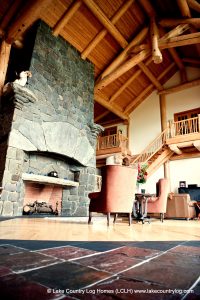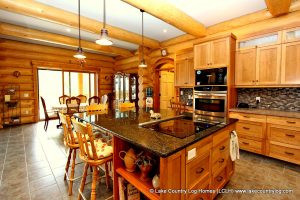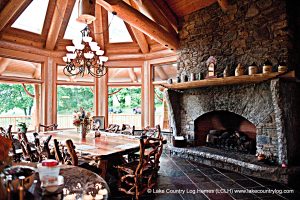|
This article aims to address some common myths about Log Homes. Hard to Maintain Absolutely not! As with anything worth having, a little time and effort goes along ways. Most importantly is starting out with a proper design. The next step is periodic maintenance with a good stain purchased from a company that specializes in log home products and not something off the shelf of a local discount store. The exterior of the home is the main area of maintenance that must be taken care of during the life of the home. The interior stained or varnished walls will never need to be redone to any normal failure . |
Log homes will rot easily Yes, wood does rot, but only between the moisture content of 30% to 60%. There is no such thing as dry rot as wood must be quite moist to rot. So a properly designed log home (or any home for that matter) with adequate roof overhangs, rain gutters, down spouts and periodic maintenance will endure of generations. Whenever I get a call from someone with a rotting problem, it is due to the fact they have defied basic logic and common sense. Furthermore, they spend 4 hours each weekend on their lawn but never seem to be concerned about the home itself. The proof in the pudding is seeing the log structures in Europe (and the United States) that are in great shape after hundreds of years. |
Termites and other wood boring insects will be attracted to log homes and set about devouring them.
Wood boring insects are not attracted to large quantities of wood. If the logs are constructed of green, unseasoned logs with the bark still on the logs, then some wood boring insects can become established under the bark during the summer and live there for several years. Once the wood is dry these insects are not attracted to the logs. |
||
|
|
Banks will not make a loan on a log homeGetting your dream home may mean building it from the ground up. Most importantly, you will need to find a mortgage specialist knowledgeable in construction financing. No of course not. As with insurance, banks and mortgage policies vary from region to region. It is best to contact your local bank or mortgage specialist to get the conversation started. |
Log homes are a fire hazardThis is an argument that goes against common sense and logic. Our logs start a mean dimension of 12”. Compared with traditional wood framing and drywall, it is easy to see when is more likely to burn. |
||
| Insurance rates are higher for log homes
This could be a case of some insurance companies however, insurance premiums are more concerned with the appraisal value and risks associated to your location. Our recommendation is to start asking these question with your current insurance representative as insurance policies vary from region to region.
|
 |
Log homes are not energy efficientMost of these rumors have been started by individuals who have never lived in a log home or are “concerned” relatives giving free advice to other relatives who are considering building a log home. Now let me say that the log home that I am talking about is one that is well designed, manufactured to modern standards and built by someone who knows what they are doing. Most building codes only recognize “R” factor which does not take into account the tightness of a well built log home. It does not take in the mass of wood which holds the heat far better than a flimsy stud home. Recently a client of ours finished his log home manufactured of dry, Western red cedar logs. At that time, he needed to get an air-tightness test from the county. It came in as the second tightest home they have ever tested…most of them being stud homes. |

